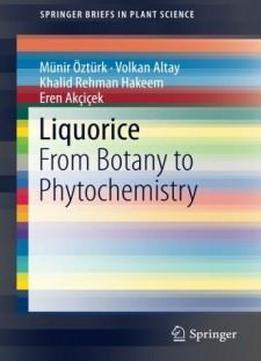
Liquorice: From Botany To Phytochemistry (springerbriefs In Plant Science)
by Münir Öztürk /
2018 / English / PDF
5.2 MB Download
Licorice (
Licorice (Glycyrrhiza
Glycyrrhiza) is one of the most widely used in
foods, herbal medicine and one of the extensively researched
medicinal plants of the world. In traditional medicine licorice
roots have been used against treating many ailments including
lung diseases, arthritis, kidney diseases, eczema, heart
diseases, gastric ulcer, low blood pressure, allergies, liver
toxicity, and certain microbial infections. Licorice extract
contains sugars, starch, bitters, resins, essential oils,
tannins, inorganic salts and low levels of nitrogenous
constituents such as proteins, individual amino acids, and
nucleic acids. A large number of biologically active compounds
have been isolated from Glycyrrhiza species, where triterpene,
saponins and flavonoids are the main constitutes which show broad
biological activities.
) is one of the most widely used in
foods, herbal medicine and one of the extensively researched
medicinal plants of the world. In traditional medicine licorice
roots have been used against treating many ailments including
lung diseases, arthritis, kidney diseases, eczema, heart
diseases, gastric ulcer, low blood pressure, allergies, liver
toxicity, and certain microbial infections. Licorice extract
contains sugars, starch, bitters, resins, essential oils,
tannins, inorganic salts and low levels of nitrogenous
constituents such as proteins, individual amino acids, and
nucleic acids. A large number of biologically active compounds
have been isolated from Glycyrrhiza species, where triterpene,
saponins and flavonoids are the main constitutes which show broad
biological activities.
The present book will discuss the botany, the commercial
interests as well as the recent studies on the phytochemistry and
pharmacology of licorice. It will also describe the side effects
and toxicity of licorice and its bioactive components, an
underrepresented subjects of importance.
The present book will discuss the botany, the commercial
interests as well as the recent studies on the phytochemistry and
pharmacology of licorice. It will also describe the side effects
and toxicity of licorice and its bioactive components, an
underrepresented subjects of importance.
It will be the first book to present global perspectives of
licorice in detail. It will serve as a carefully researched
introduction for students, healthcare practitioners, botanists
and plant biochemists; full of historical background and bridges
the gap between botany, ecology, pharmacology, as well as
treatment of diseases.
It will be the first book to present global perspectives of
licorice in detail. It will serve as a carefully researched
introduction for students, healthcare practitioners, botanists
and plant biochemists; full of historical background and bridges
the gap between botany, ecology, pharmacology, as well as
treatment of diseases.











